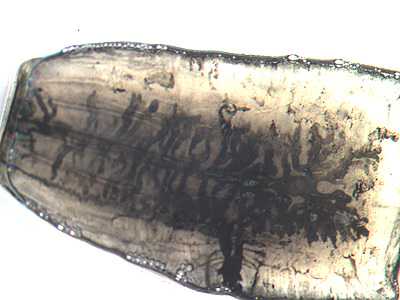
Case #246 - February, 2009
A microbiologist at a public health laboratory contacted DPDx for diagnostic assistance for identifying a tapeworm proglottid received at their lab. A wet mount was prepared from some of the transport media, and eggs morphologically-consistent with those of Taenia were observed. The DPDx Team recommended that the submitter clear the proglottid with lactophenol until the uterine branches could be observed and counted. If the branches were still difficult to see, it was recommended that India ink be injected into the genital pore. Figure A shows the image that the submitter emailed to DPDx for confirmation. What is your diagnosis? Based on what criteria?

Figure A
Case Answer
This was a case of taeniasis caused by Taenia saginata, the beef tapeworm. Diagnostic features included:
- a gravid proglottid longer than wide.
- the number of primary uterine braches exceeding 13.
This was the first proglottid that the submitter had ever received for identification. The DPDx Team extended congratulations on a job well done. Here are the steps and tips that were provided to the submitter:
- Remember to use gloves when handling unknown tapeworm proglottids, due to the risk of infection with the eggs of Taenia solium and subsequent risk of cysticercosis.
- The proglottid should be cleared using lactophenol before attempting to inject India ink. Since the amount of time necessary to clear the proglottid varies, it should be observed in intervals. It may even take overnight in some cases.
- The cleared proglottid may be placed between two large (2 inch x 3 inch) glass slides, near one edge. Applying a small amount of pressure will help stabilize the proglottid while injecting the ink.
- Best done while viewing with a dissecting microscope, a small needle, 27 gauge or smaller, attached to a 1 ml tuberculin syringe with ink is inserted into the genital pore.
- Slowly and carefully inject the ink into the genital pore and allow the ink to flow down the uterine stem and into the primary uterine branches.
- The proglottid can then be relocated more towards the center of the slides. In order to keep the proglottid flat, apply adhesive tape to the glass slides.
- If successful, the uterine branches can then be counted.
More on: Taeniasis
This case and image were kindly contributed by the Orange County Public Health Laboratory in Santa Ana, California.
Images presented in the monthly case studies are from specimens submitted for diagnosis or archiving. On rare occasions, clinical histories given may be partly fictitious.
DPDx is an education resource designed for health professionals and laboratory scientists. For an overview including prevention and control visit www.cdc.gov/parasites/.
- Page last reviewed: August 24, 2016
- Page last updated: August 24, 2016
- Content source:
- Global Health – Division of Parasitic Diseases and Malaria
- Notice: Linking to a non-federal site does not constitute an endorsement by HHS, CDC or any of its employees of the sponsors or the information and products presented on the site.
- Maintained By:


 ShareCompartir
ShareCompartir